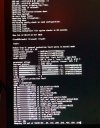Right,
AMD Radeon RX 480 hardly fits into a laptop

But I'm deducing from your X configs only one monitor; correct?
I haven't had this kind of set up at hand, but I'll try to give some suggestions.
You are using the Xorg
amdgpu driver from
x11-drivers/xf86-video-amdgpu, that probably isn't necessary. While
amdgpu is not a legacy driver, the Xorg
modesetting driver (comes with X by default) is usually the default choice; it may be the right choice here. You have to play with the Xorg configs settings. One aspect in those configs settings is that unique
Identifier-s are used to link several sections. I find Example 6 for multiple video cards badly choosen
in the Handbook:
Code:
Section "Device"
Identifier "Card0"
Driver "intel"
BusID "pci0:0:2:0"
EndSection
Section "Device"
Identifier "Card0"
Driver "nvidia"
BusID "pci0:0:2:1"
EndSection
Better:
Rich (BB code):
Section "Device"
Identifier "Card0"
Driver "intel"
BusID "PCI:0:2:0"
EndSection
Section "Device"
Identifier "Card1"
Driver "nvidia"
BusID "PCI:0:2:1"
EndSection
Card0 and Card1 are identifiers and as such should be unique. This holds as well for the
Identifier entry used in the Screen Section,
xorg.conf(5):
Rich (BB code):
SCREEN SECTION
[...]
The Identifier entry specifies the unique name for this screen.
The BusID designation I took also from
xorg.conf(5) (I've seen reported that sometimes
pci0: ... does not work).
Your X configs, all in one:
Rich (BB code):
>>> 30-amdgpu.conf
Section "Device"
Identifier "AMDGPU"
Driver "amdgpu"
Option "DRI" "3"
Option "TearFree" "on"
BusID "pci0:16:0:0" <-- could be ok but I'd use PCI:16:0:0
EndSection
Section "Device"
Identifier "AMDAPU"
Driver "amdgpu"
Option "DRI" "3"
Option "TearFree" "on"
BusID "pci0:56:0:0" <-- could be ok but I'd use PCI:56:0:0
EndSection
>>> 10-screen.conf
Section "Screen"
Identifier "Screen0" <-- identifier not unique
Device "AMDGPU"
Monitor "Monitor0" <-- tries to bind its output to monitor0
DefaultDepth 24
SubSection "Display"
Depth 24
EndSubSection
EndSection
Section "Screen"
Identifier "Screen0" <-- identifier not unique
Device "AMDAPU"
Monitor "Monitor0" <-- tries to bind its output to monitor0 as well!
DefaultDepth 24
SubSection "Display"
Depth 24
EndSubSection
EndSection
>>> 20-monitor.conf
Section "Monitor"
Identifier "Monitor0"
Option "PreferredMode" "1920x1080"
EndSection
I'd try the config settings first with one file only (say
my-amd.conf) for testing (later you can split things up again to your hearts desire); remove other
.conf files in that directory.
- Instead of using
Driver "amdgpu", try Driver "modesetting" as well.
- I'm not entirely sure, but when only one monitor is attached, you might not need to specify an unused Section "Device" where the graphics belonging to that BusID does not have a monitor attached.
- You probably won't have to specify a Section "Monitor" with only one monitor. See Monitor Section of xorg.conf(5): "... but a default configuration will be created when one isn't specified." In that case the line
Monitor "Monitor0" in Section "Screen" is probably not needed as well.
I suggest you try:
Rich (BB code):
Section "Device"
Identifier "AMDGPU"
Driver "amdgpu"
BusID "PCI:16:0:0"
EndSection
Section "Device"
Identifier "AMDAPU"
Driver "amdgpu"
BusID "PCI:56:0:0"
EndSection
Section "Screen"
Identifier "Screen0"
Device "AMDGPU"
# Monitor "Monitor0"
EndSection
# You'll have to choose which screen to send to Monitor0, depending on where your monitor is attached:
# discrete graphics card or internal graphics ("PCI:16:0:0" versus "PCI:56:0:0")
#Section "Screen"
# Identifier "Screen1"
# Device "AMDAPU"
# Monitor "Monitor0"
#EndSection
I've stripped a bit of extra options, add again if necessary or desired.
When replying, please post your
my-amd.conf and the accompanying Xorg log together, as before.
And, last but not least, welcome to the forum.


